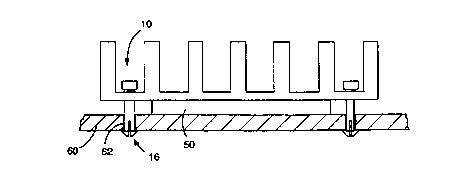Some of the information on this Web page has been provided by external sources. The Government of Canada is not responsible for the accuracy, reliability or currency of the information supplied by external sources. Users wishing to rely upon this information should consult directly with the source of the information. Content provided by external sources is not subject to official languages, privacy and accessibility requirements.
Any discrepancies in the text and image of the Claims and Abstract are due to differing posting times. Text of the Claims and Abstract are posted:
| (12) Patent: | (11) CA 2129336 |
|---|---|
| (54) English Title: | SELF-LOCKING HEAT SINKS FOR SURFACE MOUNT DEVICES |
| (54) French Title: | DISSIPATEURS DE CHALEUR A VERROUILLAGE AUTOMATIQUE POUR COMPOSANTS MONTES EN SURFACE |
| Status: | Expired and beyond the Period of Reversal |
| (51) International Patent Classification (IPC): |
|
|---|---|
| (72) Inventors : |
|
| (73) Owners : |
|
| (71) Applicants : |
|
| (74) Agent: | SMART & BIGGAR LP |
| (74) Associate agent: | |
| (45) Issued: | 1998-05-05 |
| (86) PCT Filing Date: | 1993-02-25 |
| (87) Open to Public Inspection: | 1993-09-02 |
| Examination requested: | 1995-01-05 |
| Availability of licence: | N/A |
| Dedicated to the Public: | N/A |
| (25) Language of filing: | English |
| Patent Cooperation Treaty (PCT): | Yes |
|---|---|
| (86) PCT Filing Number: | PCT/US1993/001678 |
| (87) International Publication Number: | WO 1993017536 |
| (85) National Entry: | 1994-08-02 |
| (30) Application Priority Data: | ||||||
|---|---|---|---|---|---|---|
|
A structure for attaching a heat sink to an electronic package comprising a pin (10) having a compressible point (16), the
point being adapted to pass through aligned holes in a heat sink (40) and a printed circuit board (60) so that the point compresses
as it passes into two holes and flexes back to an expanded position after it exits the printed circuit board hole opposite the heat
sink thereby holding the heat sink to the board with the electronic package (50) therebetween.
Structure permettant de relier un puits de chaleur à un module électronique comportant une broche (10) à pointe compressible (16), la pointe étant adaptée pour passer dans les orifices alignés se trouvant sur le puits de chaleur (40), et une carte à circuit imprimé (60), de sorte que la pointe se comprime lorsqu'elle passe dans deux orifices et reprend sa forme allongée lorsqu'elle ressort de l'orifice pratiqué dans la carte à circuit imprimé se trouvant à l'opposé du puits de chaleur, maintenant ainsi celui-ci sur la carte, le module électronique (50) étant situé entre les deux.
Note: Claims are shown in the official language in which they were submitted.
Note: Descriptions are shown in the official language in which they were submitted.

2024-08-01:As part of the Next Generation Patents (NGP) transition, the Canadian Patents Database (CPD) now contains a more detailed Event History, which replicates the Event Log of our new back-office solution.
Please note that "Inactive:" events refers to events no longer in use in our new back-office solution.
For a clearer understanding of the status of the application/patent presented on this page, the site Disclaimer , as well as the definitions for Patent , Event History , Maintenance Fee and Payment History should be consulted.
| Description | Date |
|---|---|
| Inactive: IPC from MCD | 2006-03-11 |
| Time Limit for Reversal Expired | 2003-02-25 |
| Letter Sent | 2002-02-25 |
| Grant by Issuance | 1998-05-05 |
| Inactive: Final fee received | 1997-11-28 |
| Pre-grant | 1997-11-28 |
| Notice of Allowance is Issued | 1997-10-23 |
| Letter Sent | 1997-10-23 |
| Notice of Allowance is Issued | 1997-10-23 |
| Inactive: Application prosecuted on TS as of Log entry date | 1997-10-16 |
| Inactive: Status info is complete as of Log entry date | 1997-10-16 |
| Inactive: IPC assigned | 1997-08-14 |
| Inactive: IPC removed | 1997-08-14 |
| Inactive: First IPC assigned | 1997-08-14 |
| Inactive: Approved for allowance (AFA) | 1997-08-14 |
| Inactive: Delete abandonment | 1997-07-04 |
| Inactive: Adhoc Request Documented | 1997-07-04 |
| Deemed Abandoned - Failure to Respond to Maintenance Fee Notice | 1997-02-25 |
| All Requirements for Examination Determined Compliant | 1995-01-05 |
| Request for Examination Requirements Determined Compliant | 1995-01-05 |
| Application Published (Open to Public Inspection) | 1993-09-02 |
| Abandonment Date | Reason | Reinstatement Date |
|---|---|---|
| 1997-02-25 |
The last payment was received on 1998-02-04
Note : If the full payment has not been received on or before the date indicated, a further fee may be required which may be one of the following
Please refer to the CIPO Patent Fees web page to see all current fee amounts.
| Fee Type | Anniversary Year | Due Date | Paid Date |
|---|---|---|---|
| Final fee - small | 1997-11-28 | ||
| Excess pages (final fee) | 1997-11-28 | ||
| MF (application, 5th anniv.) - small | 05 | 1998-02-25 | 1998-02-04 |
| MF (patent, 6th anniv.) - small | 1999-02-25 | 1998-10-16 | |
| Reversal of deemed expiry | 2001-02-26 | 1998-10-16 | |
| MF (patent, 7th anniv.) - small | 2000-02-25 | 2000-02-24 | |
| Reversal of deemed expiry | 2001-02-26 | 2000-02-24 | |
| Reversal of deemed expiry | 2001-02-26 | 2001-01-31 | |
| MF (patent, 8th anniv.) - small | 2001-02-26 | 2001-01-31 |
Note: Records showing the ownership history in alphabetical order.
| Current Owners on Record |
|---|
| AAVID ENGINEERING, INC. |
| Past Owners on Record |
|---|
| CHRISTOPHER A. SOULE |
| GARY F. KUZMIN |